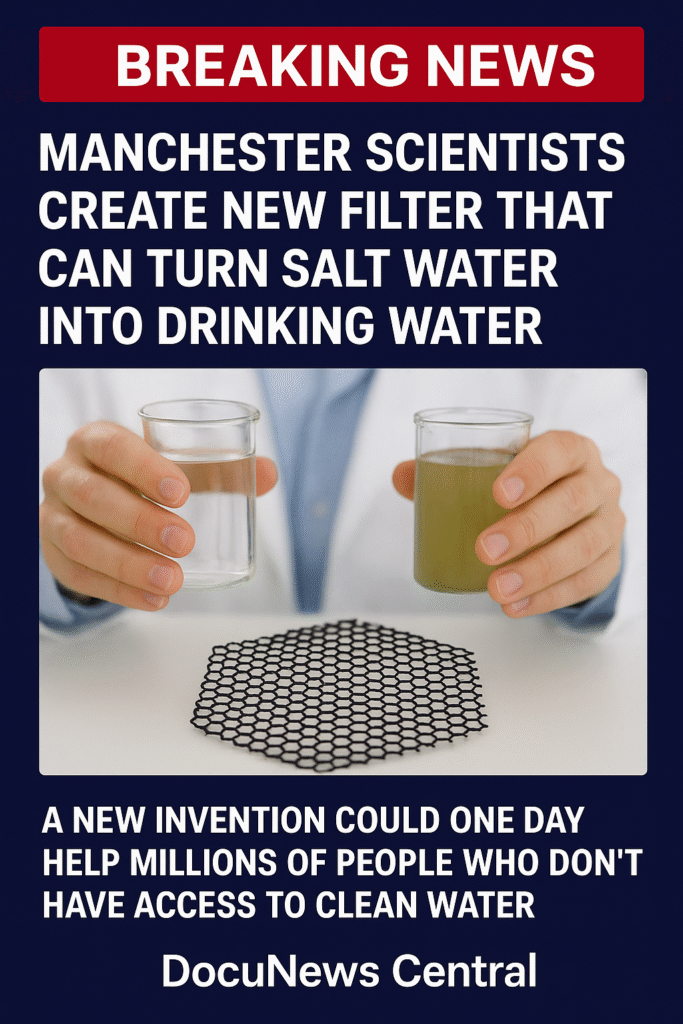
🚨 BREAKING NEWS: Manchester Scientists Create New Filter That Can Turn Salt Water Into Drinking Water
A New Invention Could One Day Help Millions of People Who Don’t Have Access to Clean Water
The Big Problem: Clean Water Shortage
Around the world today, billions of people don’t have enough clean water. Some live in dry regions where rain is rare, while others live in coastal areas surrounded by seawater — but that water is salty and unsafe to drink.
According to the United Nations, about 1 in 3 people on earth face difficulties in getting safe water every day. By the year 2030, experts predict that almost half of the world’s population could face serious water shortages.
This problem is worse in places like Africa, Asia, and the Middle East, where droughts are common and clean water systems are weak. Families sometimes have to walk long distances just to fetch a bucket of water. In emergencies such as earthquakes, floods, or wars, the situation becomes even more desperate.
How We Get Fresh Water from the Sea Today
For many years, scientists have tried to solve this problem by removing salt from seawater, a process called desalination.
The most popular method is called reverse osmosis. In this process, seawater is pushed through special filters at very high pressure. The filters allow only clean water to pass through while blocking salt and dirt.
Reverse osmosis works, but it has many problems:
It uses a lot of electricity, making it expensive.
It requires large, costly machines and infrastructure.
It creates waste brine, a byproduct that can harm the environment if not handled well.
This means that while some rich countries like Saudi Arabia and the United Arab Emirates can use it, many poor countries cannot afford it.
The New Discovery from Manchester
Now, scientists at the University of Manchester in the United Kingdom have made a discovery that could change the game.
They created a very thin filter made from graphene oxide. Graphene itself was first discovered in Manchester in 2004, and it won the Nobel Prize in Physics because of how unique it is.
Graphene is only one atom thick but is 200 times stronger than steel. It conducts electricity better than copper and is almost completely transparent.
Using this material, the Manchester scientists built a new type of membrane — or filter — that can separate salt from water with incredible precision.
How the Filter Works
Think of the filter like a very fine sieve. When seawater passes through it:
Clean water molecules slip through tiny holes.
Salt ions and impurities are trapped and left behind.
What makes this filter different from older ones is how thin and efficient it is. Even though it’s extremely thin, it is also very strong.
In lab tests, it was able to remove 97% of salt from seawater, making the water safe to drink.
Why This Is Exciting
This discovery has caught the attention of many because it could:
- Be much cheaper than existing desalination machines.
- Be smaller and lighter, meaning even villages or disaster-relief teams could use it.
- Possibly use less energy, reducing costs and helping the environment.
If successful, this could bring hope to places where children and families suffer daily from lack of clean water.
The Headlines vs. The Facts
After this news came out, many websites and social media posts rushed to share it. Some claimed that the new filter can “turn seawater into clean water in seconds” and that it “uses less energy than reverse osmosis.”
But DocuNews Central did some fact-checking.
Here is what we found:
The scientists themselves never said it works “in seconds.” The process is faster and more efficient, but not instant.
They also never officially claimed that it uses less energy than reverse osmosis. Some studies suggest it could reduce environmental impacts slightly, but it is not yet proven to be better on a large scale.
So yes — the discovery is real and very promising, but some of the claims online are exaggerated.
What the Scientists Say
Professor Rahul Nair, one of the main researchers, explained that this is a big step forward but also warned that the technology is still being tested.
He said that more research is needed to solve important challenges like:
Can the filter be produced in large amounts at a reasonable cost?
Will it remain strong and durable over many years of use?
Can it be used not only in labs but also in real-world conditions?
What Experts Outside the Team Think
Experts not connected to the Manchester team have also commented.
Dr. Elena Diez, a water technology specialist, told DocuNews Central:
“The potential of graphene in desalination is amazing. If we can make this technology affordable and durable, it could change lives. But we need to be careful. What works in the lab is not always easy to bring to the real world.”
This shows that while there is hope, there is also caution.
How It Could Change Lives
Imagine the impact if this technology becomes real:
In Africa, families in rural villages could have small, affordable devices that turn seawater into drinking water on the spot.
In disaster zones, such as during earthquakes or floods, aid workers could carry portable filters to give clean water instantly to survivors.
In cities near the coast, governments could build smaller desalination plants that cost less money and use less space.
This could help meet the United Nations’ goal of Clean Water and Sanitation for all (Goal 6).
The Road Ahead
The scientists are now working with industry partners to see how this filter can be improved and scaled up. That means making it in larger amounts, testing how long it lasts, and checking if it can be produced at an affordable cost.
It will likely take several more years before we see this technology in everyday use. But it is a hopeful sign that solutions are on the way.
DocuNews Central’s Take
At DocuNews Central, we believe this discovery is a ray of hope in a world where clean water is becoming more precious than gold. It is not a magic solution yet, but it shows how science can move us closer to solving one of humanity’s greatest challenges.
The world should keep a close eye on Manchester’s graphene project. If successful, it could save millions of lives, bring relief to thirsty nations, and show how human creativity can solve even the hardest problems.
Until then, we must continue to protect the clean water we already have and push for innovations that can make a difference for everyone.
📌 Stay connected with DocuNews Central for more updates on science, innovation, and stories that truly matter.









Thank you for this Piace of information